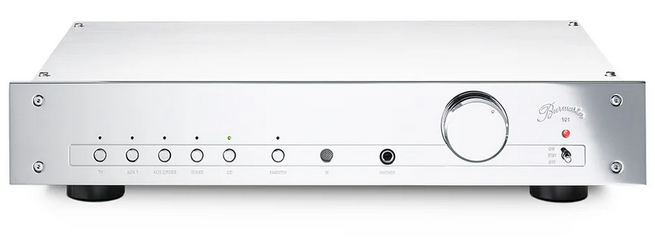Classic Line. The perfect combination of efficient power amplification with an analog power supply.
Here’s a breakdown of its components and function:
Preamplifier: This section processes the audio signal from various input sources, like a turntable, CD player, or digital streaming device. The preamplifier has controls for volume, tone, balance, and source selection, making it easy to manage audio sources and adjust sound quality.
Power Amplifier: After the preamp processes the signal, the power amplifier boosts it to a level capable of driving speakers. The power amp takes the low-level audio signal and amplifies it, providing the power necessary to produce sound at a suitable volume through connected speakers.
Key Benefits of Integrated Amplifiers
Space-saving: By combining two units into one, integrated amplifiers save space and simplify setup compared to using separate preamp and power amp units.
Convenience: An integrated amplifier provides centralized controls for the entire audio system, making it user-friendly.
Cost-effective: They often offer a more affordable entry into high-quality sound than separate components.
Types and Variants of Integrated Amplifier
Integrated amplifiers come in various types, some of which incorporate digital-to-analog converters (DACs), allowing them to handle digital audio sources directly. Many modern integrated amplifiers also include features like Bluetooth connectivity, Wi-Fi, or streaming capabilities to support wireless audio sources.
What Does An Integrated Amplifier Offer To Sound Quality?
An integrated amplifier offers several benefits to sound quality, making it a popular choice for both audiophiles and casual listeners. Here’s how it enhances the listening experience:
Clear Signal Processing
- Integrated amplifiers combine the preamp and power amp stages in one unit, often resulting in shorter signal paths. This can reduce noise and distortion, preserving the purity of the original audio signal.
- Higher-end integrated amplifiers use high-quality components (like capacitors, resistors, and transistors), which can significantly improve sound accuracy and clarity.
Power and Dynamics
- An integrated amplifier typically has enough power to drive speakers effectively, delivering rich, dynamic sound. This power ensures that audio remains clear and undistorted, even at higher volumes.
- With greater power, integrated amplifiers can produce a full range of sound, from delicate details to robust bass, enhancing the depth and impact of music.
Improved Frequency Response
- Many integrated amplifiers offer a more balanced frequency response, reproducing lows, mids, and highs accurately without over-emphasizing any particular range. This results in a natural, well-rounded sound that’s true to the original recording.
- Some integrated amplifiers include tone control or equalization options, allowing listeners to adjust bass, midrange, and treble to suit their preferences or room acoustics.
Separation and Soundstage
- High-quality integrated amplifiers can deliver excellent stereo separation, giving each channel (left and right) a clear, distinct presence. This separation enhances the soundstage, making it easier to locate instruments and vocals spatially, creating a more immersive listening experience.
- Soundstage, or the perceived space in which the audio exists, is often more pronounced, making live recordings or symphonic music sound more natural and expansive.
Minimal Distortion and Noise
- Integrated amplifiers, especially those in the mid- to high-end range, are designed to minimize harmonic distortion and background noise. This can lead to a cleaner, crisper sound without “hiss” or other unwanted artifacts.
- High-end models often feature low Total Harmonic Distortion (THD), meaning they reproduce sound with minimal alteration from the original recording.
Synergy and Tuning
- Since integrated amplifiers are optimized as a cohesive unit, the synergy between the preamp and power amp stages is generally well-tuned, ensuring that audio performance is maximized.
- Some manufacturers add custom circuits and audio enhancements tailored to their design philosophy, contributing unique character or “warmth” to the sound, which many listeners find pleasing.
Built-in DAC for Digital Quality
- Many modern integrated amplifiers come with a high-quality DAC (digital-to-analog converter), allowing them to convert digital sources (like streamed music or CDs) to analog with high fidelity. This can significantly improve the sound quality of digital audio.



